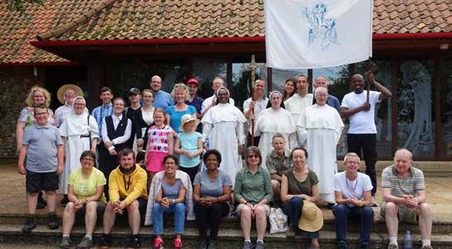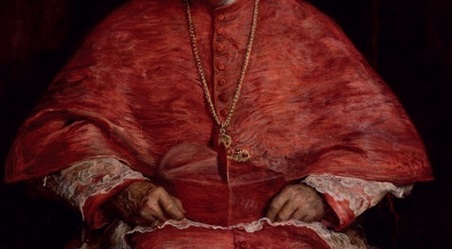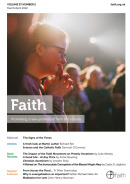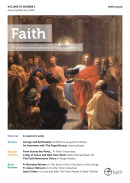Featured
At the Heart of things
Editorial:
06.11.19
At the Heart of things
The Newman canonisation brought joy. This was a celebration at the heart of the Church, a recognition for British Catholics that “one of our own” was being hailed as a saint, a sense that justice was being done to a man who was often misunderstood in his lifetime. It was also a badly-needed experience of unity in a Rome known in recent years for factions and tensions.
A Walking Pilgrimage 2019
Article:
06.11.19

A Walking Pilgrimage 2019
Sr Carino Hodder tells the story of a 20-mile-a-day walk to England’s Nazareth
A line of thirty-five pilgrims - including three habited Dominicans - singing, praying the Rosary and carrying a processional cross as they walk might strike one as an unexpected sight amongst the country lanes of Norfolk. But in fact, the St John Paul II walking pilgrimage to Walsingham, run by the Dominican Sisters of St Joseph, is a regular occurrence - and, for we sisters who run it, an integral part of our mission of evangelisation. After all, when beginning a difficult and seemingly impossible task, the wisest thing to do is to get help from someone who has done it before; and so when it comes to evangelizing England and Wales, what better way to go about it than to ask for help from the first person to hear and pass on the Good News: Mary, the Mother of God?
Trading on the attractiveness of Christ
Article:
06.11.19

Trading on the attractiveness of Christ
Fr Simon Blakesley discusses a priestly problem
One aspect of the clergy abuse crisis that has not received sufficient attention is the chronic misuse of the charisms and opportunities of priestly ministry which is a facet of most clergy abuse cases. Although there is no guarantee that a priest who is ordained for service in the church will be an attractive person in the physical sense, there are many elements of how a priest’s personality is put at the service of his ministry that invariably lead to an inter-twining of his own positive human qualities and those that he enjoys when acting in persona Christi. From time to time a priest may have ‘film-star’ good looks; one priest of my acquaintance was dubbed “Father What-a-Waste” by some of the ladies of the parish. What is said here of priests must necessarily be all the more true of bishops or cardinals.
The News Tonight – Beauty Saves the World this Christmas!
Article:
06.11.19

The News Tonight – Beauty Saves the World this Christmas!
A poem by Sarah de Nordwall
The Mysteries of the Rosary
Article:
06.11.19

The Mysteries of the Rosary
We conclude our series of Rosary meditations, compiled by a Sister of St Cecilia’s Abbey on the Isle of Wight.
The Glorious Mysteries
Interview: Meet the Mayor
Article:
06.11.19
Interview
Meet the Mayor
Joanna Bogle talks to Councillor Nicholas Bennet about Catholics and local government
We often hear pleas for more Catholics in public life, and by that we usually mean Parliament, or perhaps the mass media. We want to see and hear some voices that reflect Christian values and seem to be genuinely concerned with the common good.
Holloway on… The Word: Certain And Sure in All His Ways
Article:
06.11.19
Holloway on… The Word: Certain And Sure in All His Ways
Edward Holloway
Kneeling before the Christmas Crib we ponder the Word most certain and the certainty of His Word. For: In the Beginning was the Word, and the Word was with God, and the Word was God. This same was in the beginning with God. All things were made through Him, and without Him was made nothing that was made. ( St. John, the Prologue).
Book Review: A challenge to the Western realist mindset
Article:
06.11.19
Book Review: A challenge to the Western realist mindset
Science and Religion in Wittgenstein’s Fly-bottle by Tim Labron, Bloomsbury, 138pp, £14.50
reviewed by Hugh MacKenzie
Book Review: Being told your unborn child is disabled
Article:
06.11.19
Being told your unborn child is disabled
Because I Am – Christian Accompaniment through the experience of a pre-birth diagnosis of a possible disability by Cristina Gangemi, Redemptorist Publications, 122pp, £12.95
reviewed by Jacqueline Stewart
Book Review: The rise and fall of a revolutionary
Article:
06.11.19
Book Review: The rise and fall of a revolutionary
Annibale Bugnini, Reformer of the Liturgy by Yves Chiron, Angelico Press, 200pp, £14.50
reviewed by James Tolhurst
Book Review: On pilgrimage with Newman
Article:
06.11.19
Book Review: On pilgrimage with Newman
Newman’s London – A Pilgrim Handbook, by Joanna Bogle, Gracewing, 84pp, £7.99
reviewed by Richard Whinder
-
At the Heart of things
At the Heart of things
The Newman canonisation brought joy. This was a celebration at the heart of the Church, a recognition for British Catholics that “one of our own” was being hailed as a saint, a sense that justice was being done to a man who was often misunderstood in his lifetime. It was also a badly-needed experience of unity in a Rome known in recent years for factions and tensions.It was magnificent to have Prince Charles at the canonisation, and his beautiful tribute to St John Henry Newman, published in the British press and in L'Osservatore Romano, is worth quoting:“In the age when he lived, Newman stood for the life of the spirit against the forces that would debase human dignity and human destiny. In the age in which he attains sainthood, his example is needed more than ever - for the manner in which, at his best, he could advocate without accusation, could disagree without disrespect and, perhaps most of all, could see differences as places of encounter rather than exclusion."At a time when faith was being questioned as never before, Newman, one of the greatest theologians of the nineteenth century, applied his intellect to one of the most pressing questions of our era: what should be the relationship of faith to a sceptical, secular age? His engagement first with Anglican theology, and then, after his conversion, Catholic theology, impressed even his opponents with its fearless honesty, its unsparing rigour and its originality of thought."LandmarkA landmark event of this sort brings an opportunity to reflect on time passing, on one era giving way to the next, and the next. The Faith Movement has already seen the passing of a couple of different eras and always sees itself as being at the heart of the Church. This has not always been how others have seen us: in our first couple of decades we were sometimes regarded as “very right wing” or “hopelessly backward-looking” or “anti-Vatican II” although we have never been any of those things and will never be. We have also, and even from our earliest years, been occasionally denounced as “dangerously heretical” or “simply modernist” and are emphatically neither of those things either.FounderOur founder Fr Edward Holloway was rather proud of being a Southwark diocesan priest with his roots firmly in the soil of unfashionable South London. FAITH priests over the decades since the movement’s foundation have not shared his geographical roots – the birthplace heritage of the current membership ranges across Britain from the Scottish cities to the western peninsular – but the bond with the parish ministry remains paramount. FAITH priests are parish clergy. They baptise and absolve, preach and celebrate Mass in their parish churches, visit the sick in the local hospitals, celebrate the marriages of parishioners, and bury their parish dead.From the start, the intention was not to establish a religious order, but to nurture a bodyof priests who would teach the Catholic Faith through the particular vision of the FaithMovement, and this has been something that has fitted well within the parish system.VisionAnd this vision was not from a particular “wing” of the Church, although the movement was founded at a time when divisions were deep, and there were passionate and often angry arguments over what the Second Vatican Council had taught, and how its messages should be understood and there were liturgy wars – bleak gatherings around coffee-tables, Scripture readings replaced with banal poetry etc.FAITH priests stuck to their guns, upheld the Church’s teachings, celebrated Mass reverently without gimmicks and with a traditional style, heard confessions, taught the fullness of the Faith, and passed on that Faith to a new generation.Are things calmer now? Well, a bit. But they are also much, much grimmer. In Britain and across the West we have seen a continued steady drop in Mass attendance – something that the Vatican Council was meant to arrest – and the disappearance of a commonly held social understanding of the essentials of marriage and family life.AccuracyIt is a melancholy satisfaction to read Fr Holloway’s writing from the 1970s and 80s and to note the accuracy of his predictions concerning young people drifting away from the practice of their faith and the widening of a gulf between Catholics and the rest of society. Things are, in general, every bit as ghastly as he predicted, and in some specific areas worse. He did not foresee the imposition of nonsensical ideas under the slogan of “transgenderism”, for instance, or the attempts to force a Christian baker to inscribe a cake with a slogan insulting to Christian beliefs.The signs of the timesNo point in being smug about Fr Holloway’s impressive ability to read the signs of the times and to see what lay ahead, but we might allow ourselves a brief “told you so!” on his behalf to the vocal critics who roundly denounced him long ago and who might now admit they were wrong and he was right. And we might note that in staying loyal to Paul VI, warmly supporting Humanae Vitae, and the Credo of the People of God, Holloway was supporting a saint.StoriesSome older FAITH members occasionally remind themselves – and share with younger FAITH members – of some of the crazier tales from those early days. There was quite a strong lobby at one time of people who were convinced – or had convinced themselves – that the man who appeared on the balcony as Paul VI was in fact an impostor, with the real Pope held in a Vatican dungeon. Others ferried around dire predictions of a Church that would not survive to the year 2000, and dark assurances of visions of Our Lady or angels predicting doom at various specific dates, now long past.PriestsQuiet heroism, then, among priests who stuck to parish work while helping - through, retreats, youth gatherings, publications, pilgrimages, and more - to foster and carry forward the FAITH vision. And there was vindication as the years of St John Paul rolled along, with his missionary journeys across the globe and his superb affirmations of profound truths…and so we moved into the 21st century and crossed the threshold some had told us the Church would never see. And when Benedict XVI came to Britain, capturing hearts and minds on a scale we could never have imagined possible, there was a sense that something magnificent had occurred.Healthy anxietyNow? As we start the third decade of this century, we have uncertainty around us. We see ourselves, as always, at the heart of Church and embedded in her parish life. We would be stupid not to have a healthy anxiety as we look ahead.The ghastly sex-scandals among a tiny minority of clergy have of course tainted the whole: it will take years, tears, prayers, and heroic sanctity and perseverance to remove the stain. Our Catholic schools are desperately short of teachers who know the Faith and want to share it: most simply cannot recruit Catholics and take anyone they can find who is prepared to face the sort of problems that family-break-ups and a sordid public culture have created among today’s children. Officialdom in our country and across the West bows to honour the homosexual and lesbian lobbyists at every turn, imposing penalties on even minor officials who whisper an alternative opinion. Abortion is funded by public taxes and taught as a public good.CourageThe Church is beleaguered and we long and pray for courageous pastors, and often speak frankly among ourselves of the possibility of martyrdom. We do well to remind ourselves how unmatched we are with martyrs of old. Among us all, and especially the young, the normality of fussy dieting with much good food rejected, and of small trials or disappointments regarded as unmanageably difficult, is deeply embedded. Catholic youth leaders have become used to parental lists of special requirements for the young attendees at events or conferences - and the facilities enjoyed at the early FAITH events of the 1970s would be deemed far too primitive for today's generation. At the everyday level we are now used to levels of physical comfort and abundance that make even the 1970s and 80s seem quite primitive. Are we psychologically ready for witnessing to Christ when it might bring humiliation, disappointment, ostracism, bullying, injustice, discomfort?AdventureIt has been noted that Newman is the first non-martyr British saint canonised in modern times. His life, compared to that of Edmund Campion, was comfortable and pleasant, even luxurious. But by modern standards he lived tough: a daily cold shower, medical horrors including dentistry without anaesthetic, and so on. Above all, however, he understood that following God's call with radical generosity called for small martyrdoms daily. Do we?Witnessing to Christ calls for courage. Talking about things being bad in the Church can sometimes feel rather brave, but can often be self-indulgent. Rather more exciting is the possibility of belonging to something that may hold the solution. And just occasionally, as with the 2010 papal visit, the 2018 Eucharistic Congress, and this year’s Newman canonisation, we get a boost with the wider Church community that helps the adventure along.

















